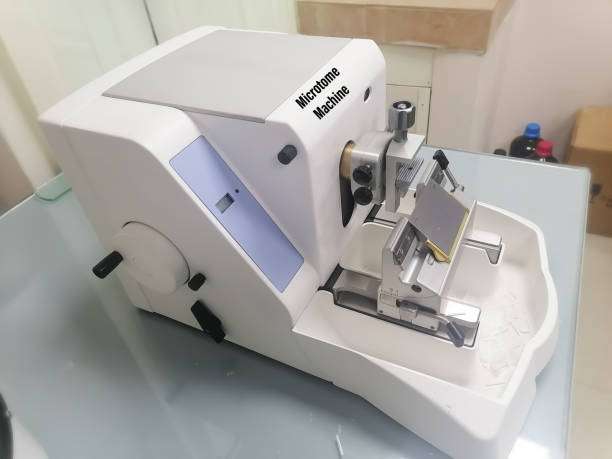What is a Microtome?
Microtomes are used for cutting paraffin tissues sections of uniform thickness. This instrument is designed to cut 1 to 60 Micron thin sections. Microtomy is a process by means of which tissue is cut into thin sections. These sections are stained and observed under microscope.

Important Parts of a Microtome
- The block holder:- In this the tissue is held in position.
- The knife carrier and the knife.
- The adjustment screws and rachet device:- These help to line up the tissue and proper relation to the knife and also provide proper thickness of tissues for successive sections.
What is a Microtome? and 7 Types of Microtome
Types of Microtomes
Various types of microtomes following are the different types of microtomes used in a Histopathology laboratory.
- Rotary microtome.
- Rocking microtome,
- Sliding microtome,
- Freezing microtome,
- Sledge, microtome,
- Ultra microtome.
- Cold (cryostat) microtome.
Use of Microtome
- Embedded tissues are cut by the either a Rotary microtome, rocking microtome or a sliding microtome.
- For rotary and rocking microtome paraffin embedding is required, while celloidin embedded sections are cut by a sliding microtome.
- A Sledge microtome is designed for cutting sections of very large blocks of tissue. For example whole Brain.
- The freezing microtome and the cold or cryostat microtome is used for cutting frozen section of a tissue. Unimpeded soft specimens are generally cut in a frozen state, since frozen condition of the specimen gives the necessary rigidity for cutting the sections. This method useful for rapid histopathological diagnosis during an operation.
- In the case of a freezing microtome, the specimen is kept frozen by liquid carbon dioxide, while the knife of microtome is warm. The cold microtome, however, is kept in a cold Chamber 20 degree Celsius and unlike the freezing microtome, the knife is also cold.
- Ultra microtome are used to prepare very thin sections up to one micrometre thickness, which are examined by using electron microscope.
Care and maintenance of the Micromtome
- Keep the moving parts of the microtome lubricated and clean.
- The surface should be cleaned frequently.
- After cutting sections, accumulated paraffin and tissue should be removed by using a soft brush.
- Clean the metal part carefully with xylene.
- Put a cover on the microtome when not in use.
What is a Microtome? and 7 Types of Microtome
Microtome Knife
The microtome knife plays most important role in producing good sections. It is capable of causing a greater number of faults than any other piece of the apparatus. Hence the knife should be sharp and well adjusted. Knife angle is also important for thin uniform sections. Angle formed between knife edge and paraffin block is the angle of clearance. It is around 2 to 5 degrees. It is necessary to avoid friction between knife and block. Bevel angle formes by convergence of 2 planes. It varies from 18 to 35 degree.
Parts of Microtome knife
- Heel
- Toe – Angle formed by cutting edge
- Honing guide (knife back)
- Handle
Types of Microtome Knife
Following are two main types of microtome knives used.
- A Heiffor Knife :- It is used on rocking microtome with a fixed handle.
- A large Knife (about 8 cm in length):- it is used on freezing microtomes and other types (about 24 centimetre of length) also used on sledge microtomes.
Classification of Microtome knives
Microtome knives can be classified by the manner in which they are ground as follows.
- Planoconcave (very concave) types of knife is used on sledge type and certain Rotary type of microtome.
- Planoconcave types of knife is used only for celloidin work.
- Planewedge type of knives are used for cutting frozen section, gaint sections and ordinary paraffin sections.
- Bi-concave knife is recommended for cutting paraffin sections on rocking and sledge type microtomes.
What is a Microtome? and 7 Types of Microtome
Care and maintenance of microtome knife.
- The knife must be cleaned with xylene after and before use.
- When not in use it must be kept inn the knife box.
- Separate knife must be used for Bony specimens.
- Knife must be greased with oil if not being used for long time.
